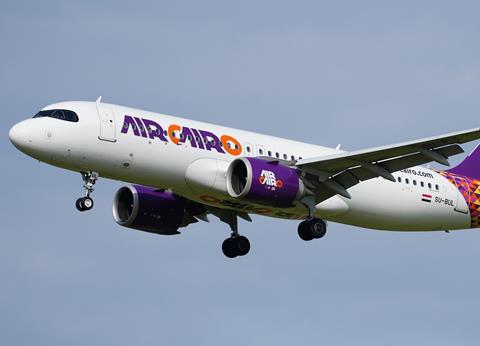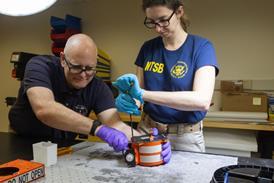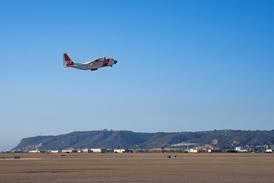German investigators believe heavy rain obscured an Air Cairo Airbus A320neo crew’s view during final approach at Hannover moments before the twinjet touched down on rough ground, off the left side of the runway.
The aircraft’s left-hand main landing-gear made rough-ground contact off runway 27L, while the right main gear touched down on the left runway shoulder before veering off as well. The nose-gear also de-rotated onto the grass.
German investigation authority BFU says the A320neo was on the grass for about 250m before being steered back onto the runway and established on the centreline.
The aircraft had been arriving from Hurghada at night on 14 October last year. Originally the crew planned for a runway 27R approach but switched to 27L because a thunderstorm was nearing from the north.

BFU states that the storm reached the airport as the aircraft was on final approach, subjecting the aircraft to gusting winds, and the jet encountered rain at about 500ft. The autopilots were disengaged at 260ft.
While visibility remained good as the A320neo crossed the threshold, according to the captain, the rain’s intensity increased significantly as the aircraft flared.
“Windshield wipers were unable to remove the amount of rain on the windshields,” says the inquiry, adding that the view of the runway lights became “blurred”.
The captain acknowledged during subsequent testimony that he could have confused the edge lights for the centreline.
Flight-data recorder information shows the aircraft was 4m left of the centreline as it crossed the 27L threshold, and then remained at about 30ft for the first 5s of the flare – a flare which lasted for 11s.
The aircraft was initially banked 2° left during the flare, and this increased to 5° in the final 5s seconds before touchdown. Cockpit-voice recordings indicate that the first officer had called bank warnings during the flare.

BFU says the aircraft drifted from the centreline towards the left edge of the runway and, although there was a late right-rudder pedal input, the left-hand main landing-gear touched down on grass. As the aircraft veered off the runway, the left main gear reached a maximum distance of 33m from the centreline.
Calculations of the wind during the approach showed it primarily consisted of a headwind component until about 50ft above ground, when there was a slight crosswind from the left of less than 3kt. About 3s before touchdown, a crosswind gust of about 10kt occurred from the right.
After touching down on rough ground about 572m past the threshold, the aircraft rolled over concrete drainage covers and edge-light fixtures. Its undercarriage picked up quantities of grass and mud, and all three sets of wheels showed signs of damage, along with the underside anti-collision beacon.
None of the 172 passengers and nine crew members was injured.
BFU has yet to reach final conclusions on the incident. It states that the jet (SU-BUM) was equipped with a rain-repelling system for the windshield – a spray activated by either pilot to improve visibility – but this was not used during the event.


























